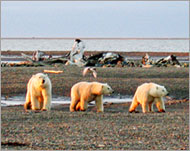‘Global warming’ shrinks Arctic sea ice
Arctic sea ice is shrinking faster than ever before – declining by 14 per cent between 2004 and 2005 – in what some climate scientists are saying is a clear sign of global warming.

Unusually warm temperatures in the region are shortening the winter ice season and have caused the perennial sea ice, which should stay frozen all year, to reduce dramatically.
On Wednesday, Josefino Comiso of Nasa’s Goddard Space Flight Centre outside Washington DC said: “The greenhouse phenomenon is actually becoming apparent in the Arctic.
“The winter warming signal is finally coming out.”
Perennial sea ice has previously been fairly stable in the Arctic, reducing 1.5 per cent to two per cent per decade over the last 25 years, but in the past two years it has melted at rates 10 to 15 times faster.
The Nasa team, based at the Jet Propulsion Laboratory in Pasadena, California, used a satellite to calculate the shrinkage.
September is the month when there is least sea ice in the Arctic, making it a good time to assess the health of the system of freezing and melting around the North Pole.
In the winter, sea ice cover in the northern hemisphere spans about 16 million sq km.
Summer ice-melt
Summer sea ice has also declined dramatically in recent years, but 2006 is unlikely to beat the record for summer ice-melt set in 2005 because of the cooling effects of a stormy August, said Mark Serreze of the National Snow and Ice Data Centre in Boulder, Colorado.
 |
|
Polar bears numbers have fallen |
“What we are seeing now is that the health of the system is not particularly good,” he said.
Scientists and climate models have long predicted a drop in winter sea ice, but it has been slow to happen.
Global warming sceptics have used this to suggest that global warming theory may not be the problem many believe.
A satellite image taken on Monday showed Arctic sea ice shrinking from its normal summer boundaries.
A strange large mass of water was also visible in the summer ice north of Alaska. The hole, called a polynya, is probably about the size of the state of Maryland and has never been seen in this area before, Serreze said.
Warmer waters
Shrinking Arctic ice means that less sunlight gets reflected and more gets absorbed, making the problem worse every year.
The ice is melting even in sub-freezing winter temperatures because the water is warmer and summer ice covers less area and is shorter-lived.
The loss of winter ice is bad news for wildlife as when it melts in summer it provides a crucial breeding ground for plankton, the bottom rung of the ocean’s food chain, Comiso said.
“If the winter ice melt continues, the effect would be very profound especially for marine mammals,” he said.
The polar bear population in Canada’s Hudson Bay has dropped from 1,200 in 1989 to about 950 in 2004 as their hunting ground have been diminished by the melt, said Claire Parkinson, a research scientist at the Goddard centre said.
James Hansen, director of Nasa’s Goddard Institute for Space Studies in New York, said: “It is not too late to save the Arctic, but it requires that we begin to slow carbon dioxide emissions this decade.”